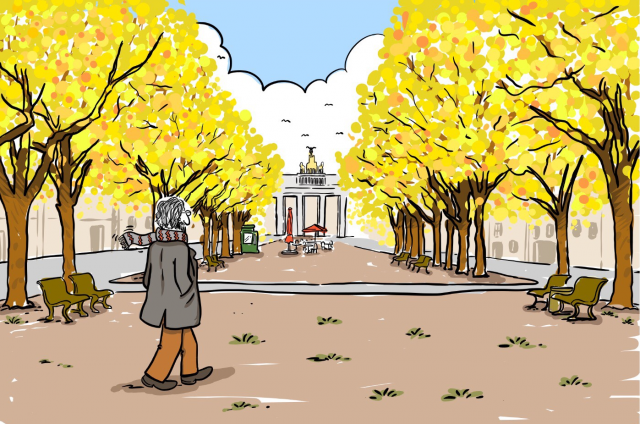
CAN DÜNDARS THEATER KOLUMNE #3
CAN DÜNDAR’IN TİYATRO SÜTUNU

AS I WALK THROUGH BERLIN
The former Prime Minister of Turkey Bülent Ecevit, who passed away in 2006, once told me this anecdote:
During a coup attempt in the 1960s, he watched as the armoured tanks drove up to the parliament building. He was able to escape in a fellow minister's car. Looking out the window, his colleague in the cabinet watched the happenings in the streets with horror, muttering the same sentence over and over: “We must build monumental buildings. They must be huge...”, probably believing that only grand buildings can shelter the power of the state.
In all the capital cities of the world that have been, and still are, sites of oppression, one encounters ostentatious buildings. They are symbolic demonstrations of power, towering and dreary. The immense sovereignty behind them should be made perfectly clear to the rank and file below... In a metropolis like New York, for example, it's the skyscrapers of the financial centres that perform this task. They brandish their power by throwing their eternal shadows onto narrow streets that almost never see sunlight. The Turkish government expresses its authority in a similar manner. It wants to build a mosque on Istanbul's Taksim Square, the centre of the country's political resistance. So that the people can feel the state's power, bow to it and obey.
One of the things I like about Berlin is that its streets are not subjected to the shadows of giant buildings. My instinct tells me that this is due to a dread of the autocracy in the city's history. In the reconstruction of Berlin, its very architecture seems to have taken a stand against the old fascist ideas ... buildings and monuments in Berlin - with some exceptions - don't stare down arrogantly at the people. One doesn't have to strain one's neck in order to look at them. The Bellevue presidential residence, for example, is modest and elegant in contrast to its counterpart in Ankara.
It's the same with the Parliament building: its interior architecture is equally discreet. The lectern, for instance, which resembles a throne in a despotic regime, is on the same level as the seats in the plenary chamber. The meeting tables for the Bundestag committees are also arranged in a circle, so that commission chairmen aren't privileged. This is a deliberate position against hierarchies. When I was recently invited to a Bundestag commission, at first I didn't know who was leading the meeting.
I liked seeing how the tradition of the “strong chairman” was broken through democratically shaped seating arrangements. I observe the same democratic spirit as I walk through Berlin:
The prerogative of pedestrians and cyclists over motor vehicles is remarkable ... This is particularly wonderful for people like me who come from countries like Turkey, where the cars are the kings of the road and trying to cross a street puts one completely at the mercy of the driver's mood. All this is well and good here, but the problem is that one can get used to it, and one day, back in one's own country, be hit.
And this “East German” at some intersections of the city, that barricades the pedestrians with his red arms first, and then sets them free with his green broad-brimmed hat! He acts like a sympathetic mascot that slipped in from the recent past ... I only wonder why it's a man and not a woman.
Compared to Istanbul, which is said to have been built on seven hills, Berlin is a flat city ... It cannot be looked down upon. It is a city without inclines. It doesn't tire one out.
In Ankara I also walked through the streets for years, especially in the Kavaklıdere district, literally translated as Poplar Brook, and I always missed the poplars and the brook that inspired its name. In Berlin, on the other hand, it's pleasant to walk along »Unter den Linden« and know that the smell of linden trees can still be found in the city ...
Street names are secret stories of a city's history. Walking in the direction of Bahriye-Üçok boulevard on the Uğur-Mumcu street in Ankara takes one on a bloody journey through time of murdered intellectuals ... And as I walk through Berlin, on the Karl-Marx boulevard or Friedrich-Engels street, I can't help but think of those who were accused or murdered in my country for “Communist propaganda”. I also wonder whether it will ever be possible to give the name “Gorki” to a Turkish theatre.
All these buildings, which one walks by, unsuspectingly, all those streets one walks along, their names on signs, pedestrians lights that demand “stop” or “go”, and all the tables one occupies in cafés, reveal much to those who are new to the city.
The beauty of a city lies not in its monumental buildings, but in minute details.
CAN DÜNDARS THEATER KOLUMNE #1
CAN DÜNDARS THEATER KOLUMNE #2